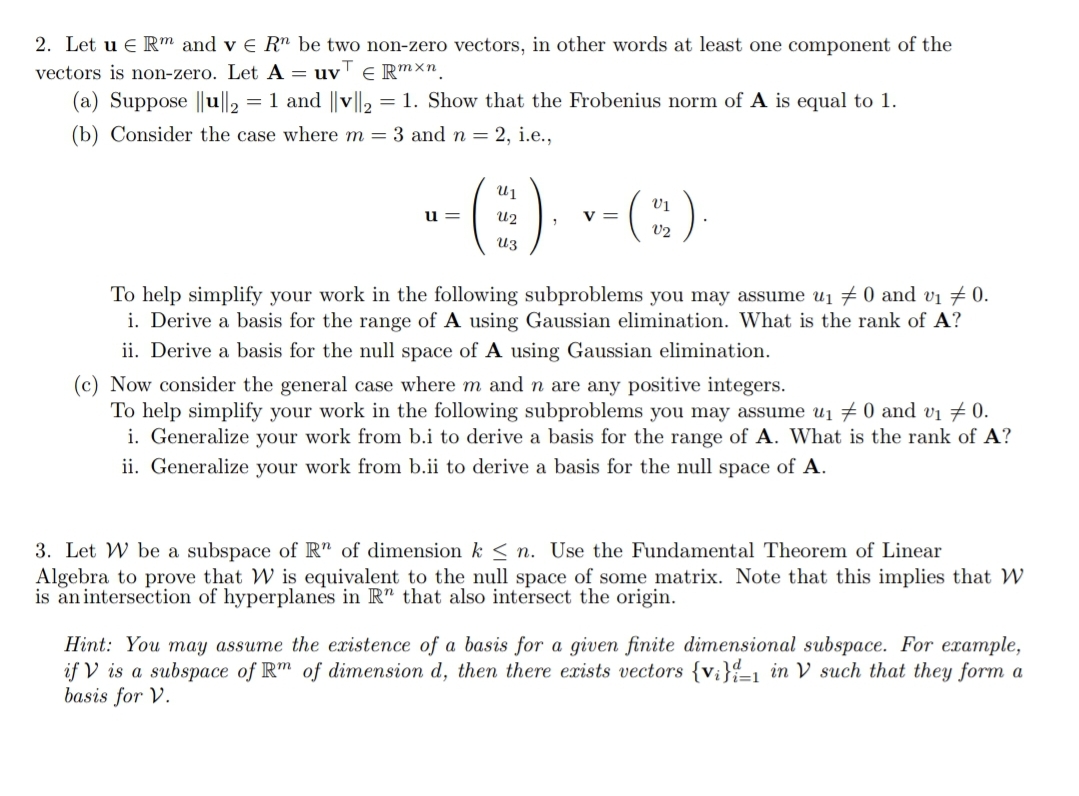3. Let W be a subspace of R" of dimension k < n. Use the Fundamental Theorem of Linear Algebra to prove that W is equivalent to the null space of some matrix. Note that this implies that W is an intersection of hyperplanes in R" that also intersect the origin. Hint: You may assume the existence of a basis for a given finite dimensional subspace. For example, if V is a subspace of Rm of dimension d, then there exists vectors {v;}-1 in V such that they form a basis for V.
3. Let W be a subspace of R" of dimension k < n. Use the Fundamental Theorem of Linear Algebra to prove that W is equivalent to the null space of some matrix. Note that this implies that W is an intersection of hyperplanes in R" that also intersect the origin. Hint: You may assume the existence of a basis for a given finite dimensional subspace. For example, if V is a subspace of Rm of dimension d, then there exists vectors {v;}-1 in V such that they form a basis for V.
Linear Algebra: A Modern Introduction
4th Edition
ISBN:9781285463247
Author:David Poole
Publisher:David Poole
Chapter4: Eigenvalues And Eigenvectors
Section4.2: Determinants
Problem 10AEXP
Related questions
Question
please send handwritten solution for Q 3

Transcribed Image Text:2. Let u e R™ and v e Rn be two non-zero vectors, in other words at least one component of the
vectors is non-zero. Let A = uv' E R™Xn.
(a) Suppose ||u||, = 1 and ||v|l2 = 1. Show that the Frobenius norm of A is equal to 1.
(b) Consider the case where m = 3 and n = 2, i.e.,
-E) --(:)
u =
U2
v =
V2
To help simplify your work in the following subproblems you may assume ui 70 and vi # 0.
i. Derive a basis for the range of A using Gaussian elimination. What is the rank of A?
ii. Derive a basis for the null space of A using Gaussian elimination.
(c) Now consider the general case where m and n are any positive integers.
To help simplify your work in the following subproblems you may assume u1 # 0 and vi 7 0.
i. Generalize your work from b.i to derive a basis for the range of A. What is the rank of A?
ii. Generalize your work from b.ii to derive a basis for the null space of A.
3. Let W be a subspace of R" of dimension k < n. Use the Fundamental Theorem of Linear
Algebra to prove that W is equivalent to the null space of some matrix. Note that this implies that W
is an intersection of hyperplanes in R" that also intersect the origin.
Hint: You may assume the existence of a basis for a given finite dimensional subspace. For example,
if V is a subspace of Rm of dimension d, then there exists vectors {v;}-1 in V such that they form a
basis for V.
Expert Solution
This question has been solved!
Explore an expertly crafted, step-by-step solution for a thorough understanding of key concepts.
Step by step
Solved in 3 steps with 2 images

Recommended textbooks for you

Linear Algebra: A Modern Introduction
Algebra
ISBN:
9781285463247
Author:
David Poole
Publisher:
Cengage Learning

Elementary Linear Algebra (MindTap Course List)
Algebra
ISBN:
9781305658004
Author:
Ron Larson
Publisher:
Cengage Learning

Algebra & Trigonometry with Analytic Geometry
Algebra
ISBN:
9781133382119
Author:
Swokowski
Publisher:
Cengage

Linear Algebra: A Modern Introduction
Algebra
ISBN:
9781285463247
Author:
David Poole
Publisher:
Cengage Learning

Elementary Linear Algebra (MindTap Course List)
Algebra
ISBN:
9781305658004
Author:
Ron Larson
Publisher:
Cengage Learning

Algebra & Trigonometry with Analytic Geometry
Algebra
ISBN:
9781133382119
Author:
Swokowski
Publisher:
Cengage